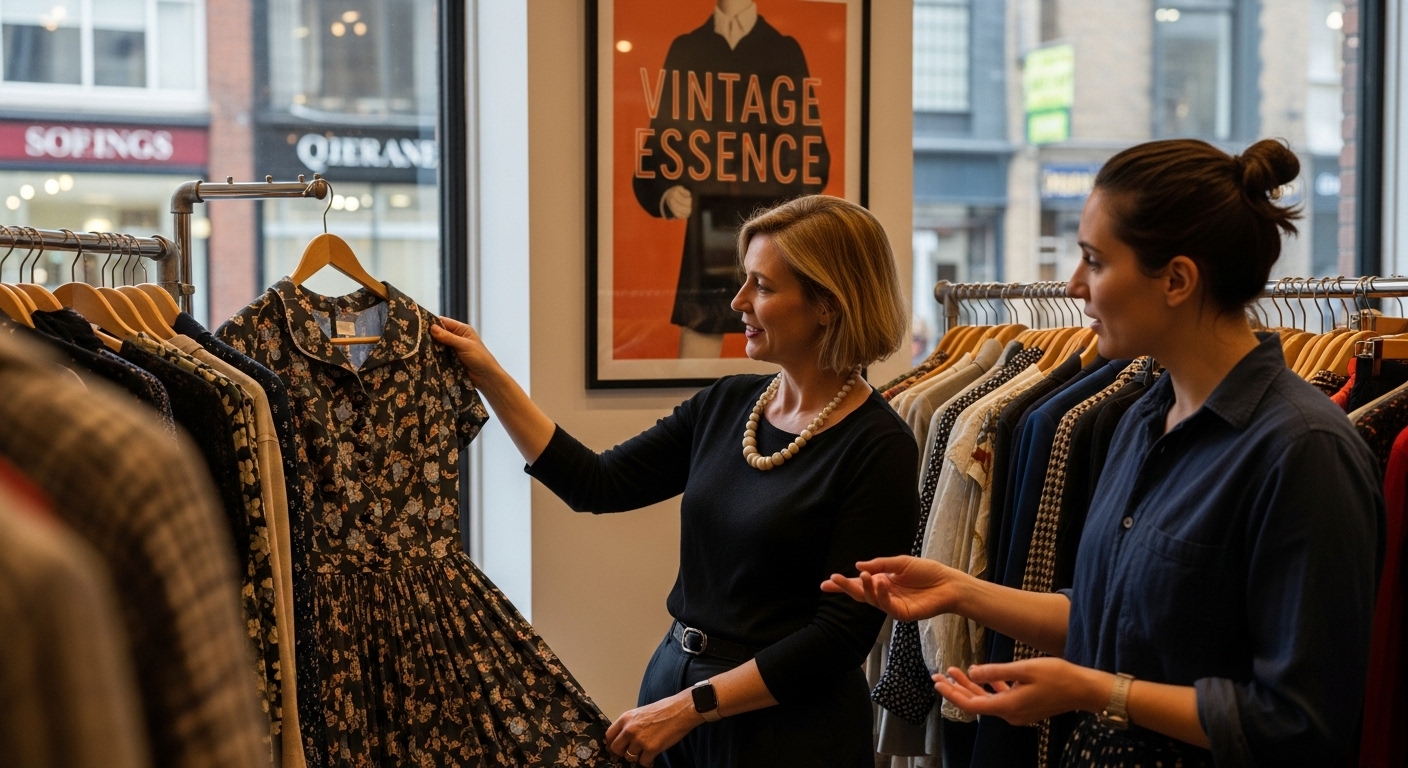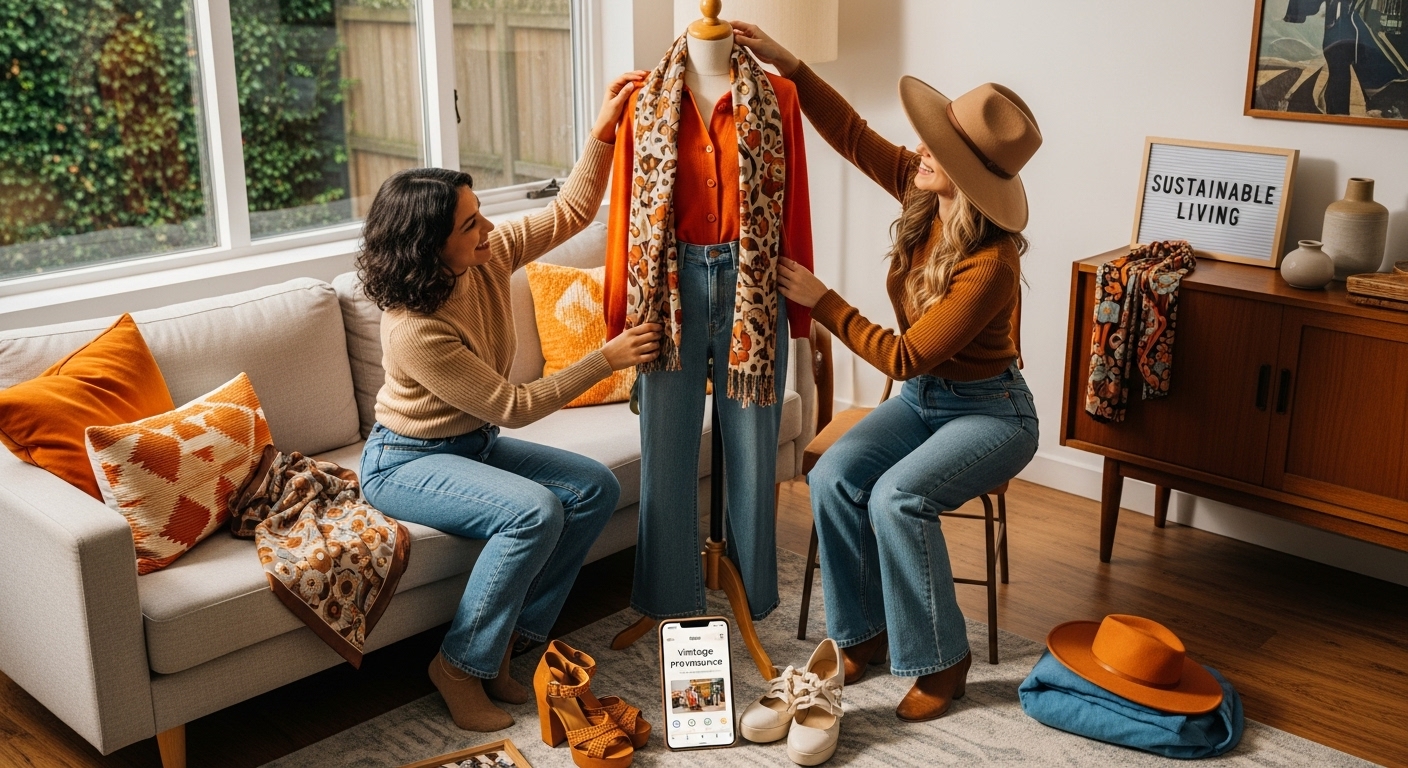What is Authentic Vintage? Understanding Its Essence
- Emma

- Sep 27
- 7 min read

Vintage is everywhere these days, stirring up excitement over its charm and distinctive style. Yet only a fraction of those so-called vintage treasures are actually the real deal. Fewer than 1 in 5 pieces labelled vintage truly meet strict age and authenticity criteria. Most shoppers miss the subtle markers that separate authentic vintage from clever copies. Get ready to uncover what really makes a piece genuinely vintage and why authenticity matters far more than you think.
Table of Contents
Quick Summary
Takeaway | Explanation |
Authentic vintage spans 20 to 100 years | Genuine vintage pieces are sourced from specific periods, distinguishing them from antiques and modern reproductions. |
Verification is key to authenticity | Assess construction details, material quality, and maker’s marks to determine genuine vintage items. |
Vintage fashion reflects cultural narratives | Each piece embodies a historical context, representing societal transformations and collective identities. |
Unearth historical craftsmanship through vintage | Authentic vintage highlights traditional manufacturing skills, preserving craftsmanship techniques from previous eras. |
Support sustainability with vintage choices | Purchasing vintage fosters responsible consumption, reduces waste, and lessens environmental impact compared to fast fashion. |
Defining Authentic Vintage: Key Characteristics
Authentic vintage represents far more than simply old clothing or aged possessions. It embodies a distinctive combination of historical significance, craftsmanship, and cultural narrative that transcends mere age. Understanding the role of vintage in style reveals the nuanced complexity behind true vintage pieces.
The Age and Origin Factor
Vintage items are not just old objects, but carefully curated pieces typically ranging between 20 to 100 years old. This specific timeframe differentiates authentic vintage from antique items (over 100 years old) and modern retro reproductions.
Below is a table distinguishing between vintage, antique, and retro items, highlighting their defining features for easy comparison.
Category | Typical Age Range | Key Features | Example |
Vintage | 20–100 years | Original to its era; period-specific style | 1950s cocktail dress |
Antique | Over 100 years | Historic; often handcrafted | Victorian-era brooch |
Retro | Varies (Newly made) | Inspired by older styles; reproduction | 1980s-style jacket made in 2020 |
The origin of a piece becomes crucial in determining its authentic vintage status.
Key characteristics that define authentic vintage include:
Precise Historical Period: Representing a specific era’s design aesthetic
Original Manufacturing Techniques: Reflecting craftsmanship of its time
Unique Material Composition: Using textiles and materials characteristic of its period
Authenticity Verification
Authentic vintage requires meticulous verification through several critical elements:
Construction Details: Examining seam finishes, button styles, and manufacturing techniques
Material Quality: Assessing fabric weight, weave, and original textile composition
Maker’s Marks: Identifying original labels, tags, or manufacturer stamps
Beyond physical attributes, authentic vintage tells a story.
This table outlines the key elements involved in verifying the authenticity of vintage items, providing a clear reference for collectors and enthusiasts.
Verification Element | Description |
Construction Details | Examining seam finishes, button styles, manufacturing |
Material Quality | Assessing fabric weight, weave, and composition |
Maker’s Marks | Identifying original labels, tags, or manufacturer stamps |
The Importance of Authenticity in Vintage Items
Authenticity transforms vintage items from mere second-hand objects into meaningful historical artefacts with profound cultural significance. Understanding why vintage fashion matters illuminates the deeper value beyond aesthetic appeal.
Cultural and Historical Preservation
Authentic vintage pieces serve as tangible historical documents, preserving design evolution, social narratives, and craftsmanship techniques from specific eras. Each genuine item represents a snapshot of cultural expression, capturing the technological capabilities, aesthetic sensibilities, and social dynamics of its time.
Key aspects of authenticity’s importance include:
Historical Documentation: Recording design innovations and societal trends
Craftsmanship Celebration: Highlighting traditional manufacturing skills
Cultural Memory Preservation: Maintaining connections to past generations
Economic and Collector’s Value
Authenticity dramatically influences an item’s monetary and collector’s value. Genuine vintage pieces with provable origins and pristine condition can appreciate significantly, becoming investment-grade collectibles. Collectors and museums seek meticulously authenticated items that demonstrate genuine historical integrity.
Authentic vintage items are distinguished by:
Verifiable Provenance: Clear documentation of origin and history
Original Condition: Minimal restoration or alteration
Rare Manufacturing Techniques: Representing unique production methods
Beyond monetary considerations, authentic vintage represents a profound respect for historical craftsmanship. These items offer wearers and collectors a direct, tactile connection to previous generations, allowing them to experience design philosophies and cultural narratives through carefully preserved material objects.
Cultural and Historical Context of Vintage Fashion
Vintage fashion transcends mere clothing, functioning as a profound cultural artefact that captures societal transformations and historical narratives. Understanding how vintage impacts style and fashion choices reveals the intricate relationship between fashion and broader cultural movements.
Social Movements and Fashion Expression
Fashion has consistently served as a powerful medium for social commentary and collective identity. Different historical periods witnessed clothing becoming a visual language through which marginalized communities expressed resistance, solidarity, and cultural pride. From 1960s civil rights movements to 1970s feminist activism, fashion became a strategic tool for communicating complex social messages.
Significant cultural dimensions of vintage fashion include:
Political Symbolism: Clothing as a form of silent protest
Identity Representation: Challenging societal norms through attire
Community Solidarity: Shared aesthetic as collective expression
Technological and Economic Influences
Vintage fashion reflects technological capabilities and economic conditions of its era. Each decade’s clothing tells a nuanced story about manufacturing techniques, available materials, and socioeconomic contexts. According to the Museum of London, clothing serves as a tangible historical document, capturing technological innovations and economic shifts.
Key historical fashion indicators include:
Fabric Innovation: Reflecting industrial manufacturing capabilities
Economic Constraints: Wartime rationing impact on design
Technological Advancements: Mass production techniques
Vintage fashion emerges not just as aesthetic choice but as a complex narrative of human experience, documenting social movements, technological progress, and collective aspirations through carefully preserved material culture.
Identifying Authentic Vintage: Tips and Tricks
Identifying truly authentic vintage requires a nuanced approach combining historical knowledge, technical expertise, and keen observational skills. The ultimate guide to identifying true vintage clothing provides comprehensive insights into this intricate process.
Construction and Material Analysis
Authentic vintage pieces reveal their age through distinctive construction techniques and material characteristics. Skilled collectors examine multiple elements to determine genuine provenance, focusing on manufacturing details that modern reproductions cannot replicate. Handmade stitching, specific fabric weaves, and unique textile compositions serve as critical indicators of a piece’s historical authenticity.
Key construction indicators include:
Seam Finishing: Examining original stitching techniques
Zipper Types: Identifying era-specific closure mechanisms
Fabric Texture: Assessing original material quality and composition
Label and Maker’s Mark Verification
According to the Vintage Fashion Guild, garment labels provide crucial information for authentication. Vintage clothing labels evolve distinctively across decades, offering precise dating clues. Collectors scrutinise label typography, printing techniques, and registration marks to validate a piece’s historical origin.
Essential label verification elements involve:
Union Labels: Tracking manufacturing periods
Country of Origin: Identifying production locations
Typography and Print Quality: Matching historical printing standards
Authentic vintage identification transcends mere visual assessment, requiring a holistic understanding of historical fashion production, cultural context, and meticulous forensic examination of material artefacts.
The Role of Authentic Vintage in Sustainable Living
Authentic vintage fashion represents more than aesthetic appreciation; it embodies a profound commitment to sustainable consumption and environmental responsibility. Understanding the timelessness of vintage style reveals how conscious fashion choices can significantly reduce ecological impact.
Circular Economy and Clothing Lifecycle
Vintage clothing operates as a powerful mechanism for extending product lifecycles, directly challenging the disposable nature of fast fashion. By rescuing and revitalising pre-existing garments, vintage enthusiasts interrupt the continuous production cycle that generates substantial textile waste. Each vintage piece represents a form of material recycling that preserves resources, reduces manufacturing demand, and minimises environmental degradation.
Key sustainable benefits include:
Resource Conservation: Reducing demand for new textile production
Waste Reduction: Preventing clothing from entering landfill systems
Carbon Footprint Minimisation: Lowering manufacturing-related emissions
Ethical Consumption and Environmental Impact
According to the Ellen MacArthur Foundation, wearing and purchasing authentic vintage directly contributes to extending clothing lifecycles. This approach transforms fashion consumption from a linear model of purchase-use-discard into a circular system of continuous reuse and regeneration.
Critical environmental considerations encompass:
Textile Waste Prevention: Extending garment usability
Energy Conservation: Reducing manufacturing requirements
Material Preservation: Maintaining existing clothing infrastructure
Authentic vintage transcends fashion trends, emerging as a sophisticated strategy for environmental stewardship, personal expression, and responsible consumption.

Elevate Your Wardrobe With Genuine Vintage Treasures
Are you searching for vintage clothing that goes beyond age and carries true authenticity, character, and a unique story? Many struggle to distinguish between genuine vintage and modern reproductions, leaving them frustrated by the abundance of imitation items on the market. The journey to finding original pieces that capture craftsmanship, quality, and cultural heritage can feel daunting. At My Vintage, we bridge this gap by offering carefully authenticated vintage fashion and retro homeware that embody the historical significance explored in our article, “What is Authentic Vintage? Understanding Its Essence”.

Experience the difference that comes with owning and wearing items that are rich in provenance, expertly curated, and environmentally responsible. Explore our extensive collection at My Vintage, where every item is chosen for its individuality and timeless appeal. If you want further inspiration or guidance on genuine vintage finds, visit our trend insights and articles for in-depth advice. Authentic vintage is more than a look—it is a commitment to sustainable style and meaningful self-expression. Now is the perfect time to discover truly unique pieces and make your mark with vintage that is as real as you are.
Frequently Asked Questions
What defines authentic vintage?
Authentic vintage refers to items typically aged between 20 to 100 years, representing a specific historical period with original manufacturing techniques and unique material compositions.
How can I verify the authenticity of a vintage item?
Authenticating a vintage piece involves examining construction details, such as seam finishes and material quality, as well as identifying maker’s marks or original labels associated with the item.
Why is authenticity important in vintage fashion?
Authenticity elevates vintage items to meaningful historical artefacts, preserving cultural narratives and craftsmanship while also impacting the economic and collector’s value of the pieces.
How does vintage fashion contribute to sustainability?
Vintage fashion promotes sustainable living by extending the lifecycle of garments, reducing waste, conserving resources, and lowering carbon emissions associated with new textile production.
Recommended







Comments